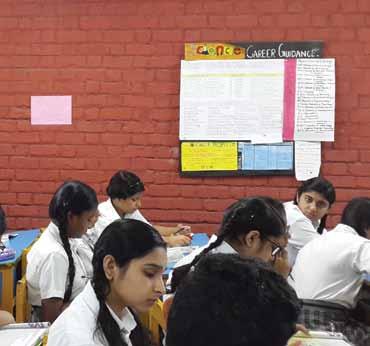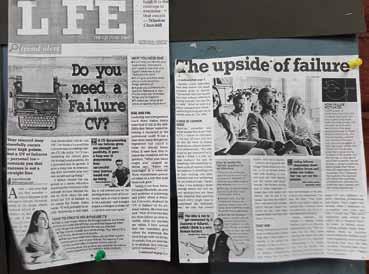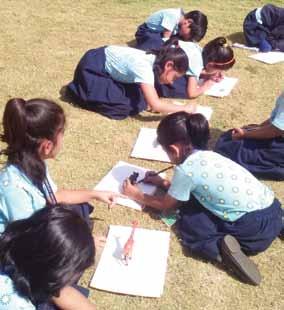
9 minute read
Finding My Own Path
from Active Learning
1.
2.
Advertisement
3.
4.
5.
6.
Now bring it into the classroom!
Ask a trusted peer to observe your class (or audio record it, if you can’t find such a peer) and note different aspects of your teaching practice like: a. How long you talk, and how much time you give for students to talk. b. How often you smile, and how often you snap c. Whether you focus only on the students who ‘get it’ or ‘don’t get it’ d. How palpable your enjoyment of engaging with students is e. And so on
Now ask your peer to look at the oft-repeated practices and write down likely beliefs that they could be stemming from.
Independently, list out what you think your own beliefs could be about each of the above practices.
Now examine the contrast: how do you come through? And what do you profess to believe?
Notice the discomfort that this triggers in you: reflection is seldom a pleasant process! It is precisely because it takes you out of your comfort zone that it prevents you from trundling along mechanically!
See what you wish to drop/change/tweak: your practice or your belief? Send in your findings to thinkingteacher22@gmail.com.
school and tended to dominate the conversation. A new and young teacher boldly suggested one day that teachers rotate this responsibility. And it was only because of her suggestion that we then had a staff meeting anchored by one of our colleagues. I remember being struck by the utter poise and aplomb of that day’s chair. Only then did I realize that all along, I had assumed her capabilities to be less!
There is far more that you will gain by reading this rich paper. So I am going to leave you with just so much! As always, there are a few suggestions for you to bring this into your classroom! And if you are online, then bring it into your virtual classroom!
The author is Founder Director of Thinking Teacher (www.thinkingteacher.in), an organization that networks with teachers across the country. Thinking Teacher aims to awaken and nurture the reflective practitioner within each teacher. By taking (action) research out of the classroom, Thinking Teacher develops the (action) researcher in the teacher. And then, by bringing research into the classroom – as in this series – Thinking Teacher’s goal is to help build deep inquiry and rich learning into the teaching process. The author can be reached at < neeraja@thinkingteacher.in>.
When hands- on learning became a habit
As a student of class VII of De Nobili School, Maithan, I think of my geography class. My young and dynamic teacher would ensure that the class was interactive. Hence, after teaching us a particular topic she would throw questions related to the facts given in the book and we would willingly participate, recapitulate all the essential details of the topic and thus learn the maximum. Since the class was interactive, I used to love my geography class and also my geography teacher.
Years down the line, I am now a teacher in Bharatiya Vidya Bhavan’s R.K. Sarda Vidya Mandir, Raipur and I carry forward the learning from my geography class by upholding the principle that my class should also be interactive.
In my school, I deal with the students of classes IX and X. In one of the academic sessions, the learning began with the batch of class X B and I found that my learners would take a back seat, be passive and allow me to indulge in maximum explanation. Though there was some interaction when they would share their thoughts and feelings in the class, my desire was to make them explain the lesson too. So, one day, I came up with an activity that I
Varsha Singh
termed “One Level Up” and “One Level Down”.
The class was divided into two sections. One area of the class was marked One Level Up and the other was marked One Level Down. First, all the learners occupied positions in One Level Down. Now, 6a part of the literature lesson “The Letter” was read aloud, and after the read aloud session, the young learner who felt confident enough to explain the part that was read out would begin the explanation, satisfy the queries of the others and finally get a pass certificate by the others to book his/her place in the area One Level Up. As the lesson flowed, so did the urge to occupy a place in the One Level Up area and the learners tried their best to satisfy the others with their elucidation.
At length, the activity ended and so did the lesson. Altogether, we observed that there were just seven to eight students left in the One Level Down area and the rest of the class, about 29 students, had happily proved their worth and occupied the other area. Also, the explanation of the entire lesson was done by the students, and I had remained almost passive, just facilitating my learners. This boosted their confidence levels and I received feedback that they really enjoyed the activity.
Now the impact of the activity was such that henceforth, every prose or poem that was taken

Photos courtesy: Varsha Singh

up elicited the desire of my learners that I remain passive and allow them to be active! That was my reward.
Now let’s move to class XII. In order to enhance their ability to write an article, I came up with the thought of reading good newspaper articles in the class. Now, after reading a few in the class, my learners’ interest in reading these was actually stimulated, and there was a good variety of issues that we had covered – like dealing with stress, the education system, tourism, environment, dealing with failure and many such problems. After reading the article, the class always participated in a discussion related to the article and gradually, this habit bore fruit, as after every lesson there was some time that we all spent together having a very healthy discussion about the different aspects of life that the various literature lessons covered. I realized that I had easily attained my objective of making my class interactive.
I believe that interaction between people in richer and better ways connects human beings better and in turn makes the world a better place to live in. I just hope that through my lessons I am able to contribute my best to making the world a better place.
The author teaches English at Bhavan’s R.K. Sarda Vidya Mandir, Raipur (CG). She can be reached at < honey_khare123@yahoo.co.in>.
The invisible route to language
Vatsala Hegde
Photos courtesy: Vatsala Hegde

Book Exhibition T eaching for me has always been a passion. I started my career in Hiranandani Foundation School, Powai and now for the last 20 years I have been teaching at J H Ambani School, now known as Reliance Foundation School (EM), Lodhivali in Raigad district.
The school is located in a rural area where we cater to children from varied backgrounds. So teaching them English has always been a challenge and a wonderful experience.
I would like to share some of my best practices which have helped the children learn not just the language but also values for life.
In class 1 when I was the class teacher, the children were hesitant to speak in English. I decided then to follow the invisible curriculum, i.e., not based on lesson plans, but everyday teaching practices which blend with the curriculum. The practice has been to teach them poems and rhymes not found in the syllabus. These rhymes were taught with actions. The actions invariably helped in developing their vocabulary without me having to teach them the meanings, for example words such as heavy, little, pick, carry, etc., are learnt in their own fun way proving right Howard Gardner’s kinaesthetic intelligence.
Skits are another way to improve spoken skills. I prepare short dialogues where children enact roles highlighting concepts like cleanliness, use of
Drawing with Nature Little chef activity


magic words and so on. Vocabulary development that takes place with songs, rhymes and skits in the early years (i.e., till seven years) is much more than what can be learnt from textbooks. When children come across these words in their books they are able to relate to them easily.
Another practice I have been using is to give instructions in English without translating to their mother tongue or Hindi, for example, if they need to form a line to go for the physical education period, I ask them to come out and form a line. At the same time I use words like 'short boy', 'shortest girl','tallest boy', 'stand here' come behind','come between', 'go infront' by physically holding their hands and making them stand. After a few weeks, the children themselves start using these words.
Teaching can go beyond textbooks. There are various such practices I use, such as asking children to distribute the workbooks of their friends and while doing so, make them use phonics and blended words which at times they guess but later at the end of the session they are able to read the names of their friends on the label.
Another thing which is close to my heart is to initiate a love for reading books other than their textbooks. I have motivated children by getting books like Amar Chitra Katha to class to take them on a journey through mythology, history, and other regional stories of India. Mind you, it’s a tough task nowadays in this digital age but there a few students who come

Painting with shadows back to me to show their collection of books. STAR PERIOD (Stop Take A book and Read) has been started in our school once a month with the initiative of our school librarian and me, where children, teachers and the non-teaching staff bring reading material from home. When a bell rings, they stop their work and start reading. It`s a small step to bring back the reading habit.
I was the pre-primary coordinator for seven years. During this time I introduced the concept of integrated learning. In integrating subjects in preschool, learning becomes easier. If we are teaching shapes, for instance, a rectangle, we integrate it with the number four by highlighting the four sides. With the alphabet, instead of teaching D for Dog, we relate it to 'D' for door revising the shapes with craft activity. All these activities take place with lot of conversation and even concepts such as open – close (door), big sides – small sides (rectangle), are taught. A lot of learning and concept building can be done in informal ways in the classroom which children enjoy.
I have always believed that children learn using their head, hand and heart and it is for us teachers to provide them the opportunities.
The author is an educator who firmly believes that education is not bounded within the four walls of the classroom. She is now the primary coordinator at Reliance Foundation School, Lodhivali. She can be reached at < hegdevats@gmail.com>.

Tree planting










